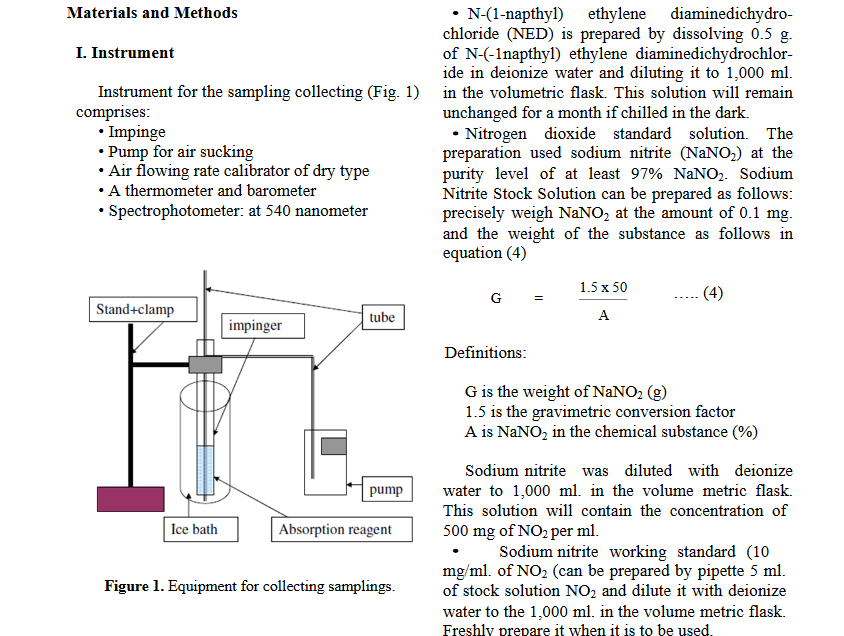The Relationship between Nitrogen Dioxide Concentrations in the Atmosphere Measured by the Sodium Arsenite Method and the Chemiluminescence Method
Keywords:
Air pollution sampling, Chemiluminescense, Nitrogen dioxide, Sodium arseniteAbstract
The relationship between the nitrogen dioxide concentration measured by the Sodium Arsenite method and the Chemiluminescence method, aimed at developing a device for measuring nitrogen dioxide in the atmosphere by means of the Sodium Arsenite method
and studying the correlation between the concentration of nitrogen dioxide in the atmosphere which was measured by Sodium Arsenite method and the Chemiluminescense method done by the Pollution Control Department, Thailand. In this research sampling
collection of nitrogen dioxide concentration in various conditions by the Sodium Arsenite method was compared with that by the Chemiluminescence method done by the pollution control Department at the Air Quality Measurement Station at the Din Dang district,
Bangkok. It was done by one-hour average value totaling of thirty data. The research result found that the sampling collection with the flowing rate of 160 ml/min and the absorption reagent with mixture of 0.2 M sodium hydroxide and 0.015 M sodium arsenite had the
highest relationship to the measurement result done by the Pollution Control Department at a statistical significance level of 0.05 with the value of correlation coefficient at 0.658 which had a high relation
References
Air Science Group, Environmental Protection Department. (2012). A report on the results from the Air Quality Monitoring Network
(AQMN). Hong Kong: The Government of the Hong Kong.
Choo-in, S. (2013). Air pollution sampling and analysis. Bangkok: Chulalongkorn University Press. (in Thai).
Choo-in, S. 2013. Air pollution. Bangkok: Chulalongkorn University Press. (in Thai).
De Nevers, N. (2000). Air pollution control engineering (2nd ed.). Singapore: McGraw-Hill. Kampa, M. & Castanas, E. (2008). Human health
effects of air pollution. Environmental Pollution, 151, 362-367.
Lai, H.K., Bayer-Oglesby, L., Colvile, R., Gotschi T., Jantunen, M. J., Kunzli, N., Kulins-kaya E., Schweizer, C. & Nieuwenhuijsen, M. J.
(2006). Determinants of indoor air 28 concen-trations of PM2.5, black smoke and NO2 in six European cities (EXPOLIS study).
Atmospheric Environment 40, 1299-1313.
Lewne, M., Cyrys, J., Meliefste, K., Hoek, G.,Brauer, M., Fischer, P., Gehring, U., Heinrich, J., Brunekreef, B., Bellander, T. ( 2004).
Spatial variation in nitrogen dioxide in three European areas. Science of the Total Environment, 332, 217-230.
Lodhi, Z. H. (2006). Measurement of ambient concentration of NO2 in different cities of Pakistan using diffusion samplers. Islamabad:
Pakistan Environmental Protection Agency.
Suadee, W. (2003). Air pollutant sampling and analysis. Bangkok: Rajabhat Institute Suan Sunandha. (in Thai).
Hänninen, O., Hoek, G., Mallone, S., Chellini, E., Katsouyanni, K., Gariazzo, C., Cattani, G., Marconi, A., P. Molnár, Bellander T. &
Jantunen, M. ( 2011). Seasonal Patterns of Outdoor PM Infiltration into Indoor Environments: Review and Meta-analysis of
Available Studies from Different Climatological Zones in Europe. Air Quality Atmosphere & Health Journal, 4, 221–233.













